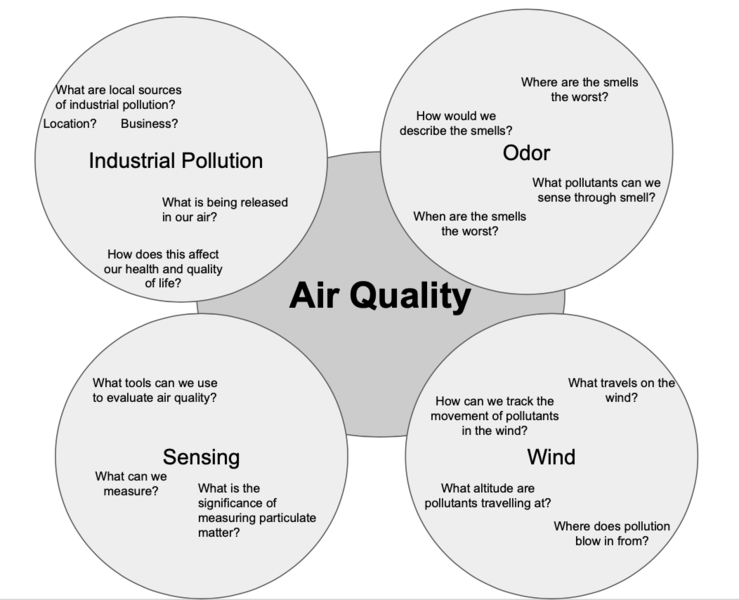This lesson is part of a series of lessons designed for educators to facilitate student-led inquiry around environmental topics. If there are time constraints, this lesson can be split into two at the Elaborate portion of the lesson. During Phase I of this series, students work towards identifying and learning about environmental topics.
You can learn more about this series here.
You can access this lesson plan as a Google Doc here.
Overview
Time: 85 minutes
Materials: Large whiteboard or collaborative online document. Optional: Markers & sticky notes
Guiding Question: What do we already know? What do we want to learn?
Objective: Students synthesize their research to date on the topic, identify knowledge gaps, and unusual occurrences that merit further investigation.
Engage
Time: 10 minutes
Challenge students to spend 3 minutes writing down all the things they know about the environmental topic so far. As a group, students will share the things they’ve written down. These will be gathered as one list, either on a whiteboard or collaboratively online in a shared document. If a student repeats something that has already been said, ask them to expand or elaborate upon the statement.
For example, if a student has already said “The streets near our school flood”, another student who also wrote this as their piece of knowledge, should be asked to provide more details. In what circumstances do the streets flood? Which streets flood? Which part of the street floods? How long does the water last?
Explore
Time: 20 minutes
Sources of Knowledge:
Students will identify the sources of their knowledge and how they overlap. To do this, each piece of knowledge listed will be sorted into three groups. Students should decide if a piece of knowledge comes from: 1- their lived experience, 2- the work of other community science projects, 3- their online research, or 4- some combination of the categories above.
This could be done in a few different ways: - If all of the ideas are listed on the whiteboard, circles in different colors could reflect each source, with more than one circle representing more than one source of knowledge. - If all of the ideas are listed online in a collaborative document, different highlight or font colors could represent the sources. - Students could move ideas into different parts of a chart on paper, or on a larger scale via posterboard and sticky notes.
Reflect: Students might notice that some pieces of knowledge are supported by multiple sources. Ask students what that means? Is a piece of knowledge more meaningful or trustworthy if it has been verified by multiple sources?
Look at the pieces that have only one source. Are there clear reasons why something can only be learned through a particular stream of knowledge?
For example, could online research have shown street flooding in our hyper-local area? Would satellite images show something that lasts only a short time? Would other communities have investigated this problem?
Explain
Time: 10 minutes
Students will be asked to answer the question: what does our research tell us about our environmental issue? They will share their conclusions with the group. These should be written down on the white board, or added to a collaborative online document, like a Google Doc. For each conclusion drawn, students should identify how their research to date supports the idea. Make special note of conclusions that don’t have robust support. These may be topics for further investigation.
Elaborate
Time: 30 minutes
Mind Mapping:
Students will do a brief mind-mapping activity to identify the areas that need more study. Each student starts off with a blank piece of paper. In the center of that piece of paper, students will write down the environmental issue they’re studying. They can write one or two words, a sentence, a description, whatever brings to mind the topic for them.
In the next layer around the central issue, students will write down as many facets to the issue as they can think of. For example, “air quality” could be surrounded by words like industrial pollution, odor, wind, and particulate matter.
In a third layer, students will list the things that they want to know about each facet in a circle around that facet. A mind map produced by a student may look like:

Students will share their questions so that we can compile a list of things we want to know. Briefly, students will evaluate each question’s merit as a driving research question. They should think about the following criteria?
- Is it measurable or something we will need to research?
- Is it within the geographic scope of our study?
- Can we think of a tool that could answer this question?
- Over what kind of time period could this question be answered? Hours? Days? Weeks? Months?
As a group, identify which* of the listed questions will drive their environmental monitoring study.
*A well designed study will focus on more than one facet of an issue and answer more than one question. Students should be encouraged not to limit themselves by investigating only a single question further.
Evaluate
Time: 15 minutes
Update the Public Lab Community on the Project’s Progress: Students should update the Public Lab Community on the project’s progress by posting a research note. This note should be linked back to their initial issue brief. In their research note, students will summarize their research and define the questions/topic that merit further study. Students can share the charts they created detailing they know and how they know it, or use this information to write a short piece.
Additionally, students should be encouraged to post some of the questions they won’t be monitoring (i.e. research-based questions, things that are outside of the scope of the project) as questions on Public Lab.

1 Comments
@purl has marked @purl as a co-author.
Reply to this comment...
Log in to comment
Login to comment.